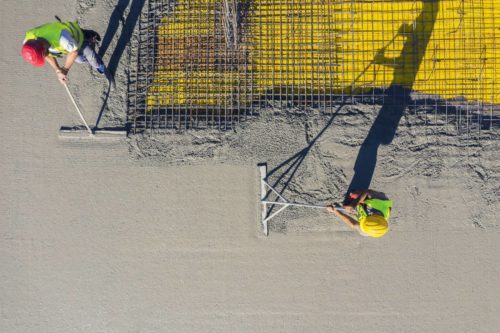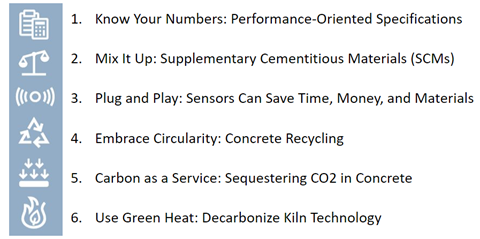
Giving America’s Infrastructure a Clean Start
RMI Releases a Guide on How to Reduce Emissions from Concrete
America’s infrastructure is in rough shape, scoring a C- this year and floating at a grade average over the past two decades that would not make our founding parents proud. After months of negotiations, the Senate recently approved an ambitious infrastructure package to rebuild our failing infrastructure. As congress works through the details of the package, and a summer with record high heat from Seattle to Phoenix plagues the country, climate change continues to negatively affect our communities and infrastructure.
Physical infrastructure such as roads and bridges designed for a particular climate may fail more quickly as extreme weather increases the frequency of freeze-thaw cycles that cause cracking and potholes and high temperatures cause roads to buckle. These stressors not only add costs to the design and retrofit of our infrastructure but also decrease reliability and safety for users. Rebuilding the nation’s infrastructure with low-carbon materials can help reduce the impact on climate change that is causing increasingly common extreme weather events.
As the infrastructure bill circulates through Congress, government agencies across the United States are leveraging their purchasing power to build infrastructure with low-carbon materials. One such policy is the US General Services Administration’s low-embodied-carbon procurement principles that target materials used in building construction. Other legislation popping up across the country include California’s Buy Clean Act, New York and New Jersey’s LECCLA-Low Embodied Carbon Concrete Leadership Act, Colorado Buy Clean, and legislation in Portland and Marin County. These regulations aim to reduce the carbon impact of materials used in the construction of municipal buildings or infrastructure projects and establish a precedent for a clean start on repairing America’s infrastructure.
How Clean Procurement Regulation Affects the US Concrete Industry
Concrete is one of the most widely used materials in infrastructure and building construction and accounts for a large share of global greenhouse gas (GHG) emissions. The production of cement, the primary ingredient in concrete, alone accounts for 8 percent of global emissions. As industry and governments devote more attention to embodied carbon—the GHG emissions associated with the manufacturing, transportation, installation, maintenance, and disposal of building and construction materials—concrete has become one of the biggest targets for reduction.
A recent analysis by RMI shows that simply by specifying concrete products with lower CO2-equivalent (CO2e) content, the embodied carbon of a commercial building project can be reduced by up to 33 percent. Low-embodied carbon procurement policies limit the CO2e of a given product, expressed as global warming potential (GWP), which measures a material’s GHG emissions over its lifecycle. Manufacturers disclose the GWP and other environmental impacts of their products in Environmental Product Declarations (EPDs). Concrete products have the largest availability of EPDs in the United States. Combined with concrete’s large environmental impact, this makes these products good candidates for procurement policy and other legislation aiming to reduce embodied carbon.
A Growing Market for Low-Embodied Carbon Solutions
Spurred by recent sustainable procurement policies, the demand for low-carbon concrete is growing significantly. Embodied carbon has been a key topic in the cement and concrete industry for decades and there are several market-ready solutions and emerging technologies to meet the demand. RMI’s recent Concrete Solutions Guide highlights six solutions to lower the embodied carbon of concrete without compromising financial and material performance.
One of the simplest ways to reduce embodied carbon emissions in concrete is to recycle existing materials. With only 140 million tons of concrete recycled annually in the United States, just 13 percent of the total natural aggregate produced for construction, recycled concrete has huge potential to grow as a resource. For nonstructural applications, recycled concrete sourced on-site offers approximately 50 percent cost savings compared with natural aggregate.
In addition to concrete recycling, concrete producers can substitute up to 40 percent of traditional cement with alternative materials known as supplementary cementitious materials (SCMs). These include waste or by-product materials such as fly ash, ground glass, and blast furnace slag, or natural materials such as volcanic ash. There are some barriers related to both the availability of these materials and their allowed use as dictated by prescriptive specifications. Even so, using SCMs has the potential to reduce emissions up to 80 percent for a given application and reduce the cost of the cement blend by up to $45/ton.
Using recycled and alternative ingredients in concrete alone will not solve the concrete industry’s impact on climate change. The emissions associated with the energy used to heat kilns to the high temperature required to create cement must be addressed as well. Cement kilns are the site of 90 percent of the emissions associated with concrete production, and about half of these emissions can be mitigated through interventions at the kiln itself. These include efficiency upgrades and switching to sustainably produced biomass-based fuels, electrification, and renewable energy sources.
At the cutting edge of concrete innovation is technology that enables concrete to capture and store carbon dioxide. Sequestering CO2 in concrete traps carbon dioxide through the process of mineralization, which takes place either by injecting CO2 into the concrete during the mixing process or curing concrete in a CO2-rich atmosphere. These up-and-coming sequestration technologies can reduce the embodied carbon of concrete and show promising performance benefits such as improving the material’s compressive strength and cure times.
Industry Stakeholders Rebuilding Together
The cement and concrete value chain feature a complex network of stakeholders. The Concrete Solutions Guide provides resources to help foster relationships between these stakeholders to advance sustainable procurement and synergies in climate-conscious innovation. As America looks toward rebuilding the nation’s infrastructure, concrete producers, cement manufacturers, developers, designers, contractors, and policymakers all have something to bring to the table in making low-embodied-carbon concrete ubiquitous across the country.
Explore the Concrete Solutions Guide
Learn how to put low-carbon concrete into practice by exploring the six solutions detailed in the Guide:
